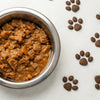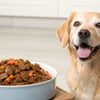How Much Wet Food to Give Your Dog: A Comprehensive Guide
- Houndsy
Table of Contents
- Introduction
- The Importance of Proper Feeding for Dogs
- Understanding Feeding Guidelines for Canned Dog Food
- Calculating the Right Amount of Canned Food Based on Your Dog's Weight
- Considerations for Mixing Canned and Dry Food
- Adjusting Feeding Based on Life Stages and Health Needs
- Conclusion
Introduction
Did you know that around 59% of dogs in the United States are classified as overweight or obese? This startling statistic highlights the pressing need for pet owners to understand proper feeding practices, especially regarding wet dog food. As devoted dog parents, we often find ourselves juggling various feeding options, wondering how much wet food to give our canine friends to ensure their health and happiness. Knowing the right amount of wet food can significantly impact our dogs' overall well-being, preventing obesity, nutritional deficiencies, and associated health complications.
In this blog post, we aim to provide a detailed exploration of the intricacies surrounding wet dog food portioning. We’ll cover essential factors like how to calculate the ideal daily serving size based on your dog’s weight, age, and activity level. Additionally, we will discuss best practices for mixing wet food with dry kibble for a balanced diet and tips for adapting these guidelines as your dog ages or faces health changes.
By the end of this article, we hope to equip you with the knowledge to confidently serve your dog the right amount of wet food, ensuring they receive the appropriate nutrition without the risk of overfeeding. Let’s embark on this journey to enhance our dogs' eating experience together!
The Importance of Proper Feeding for Dogs
Feeding your dog the correct amount of food is not merely about filling their bowl; it's crucial for maintaining their overall health and well-being. Understanding how much wet food to give your dog plays a significant role in preventing obesity—an issue linked to various health problems such as joint disorders, diabetes, and heart disease. Consequently, misfeeding can lead to serious long-term implications, including a reduced quality of life and decreased lifespan.
Proper portion control fosters a balanced diet tailored to your dog's individual needs. Here at Houndsy, we recognize the significance of harmonizing the feeding experience with elegant design and functionality, like our flagship Houndsy Kibble Dispenser that promotes perfect portioning effortlessly. It’s not just about practicality; feeding should be a delightful experience for both us and our pets, enriching our daily routines.
Key Points on Proper Feeding:
- Helps maintain a healthy weight.
- Reduces the risk of obesity-related health issues.
- Ensures balanced nutrition tailored to your dog's lifestyle and life stage.
- Enhances the feeding experience, turning mealtime into a joyful ritual.
Understanding Feeding Guidelines for Canned Dog Food
Feeding guidelines for wet dog food can often feel overwhelming, especially considering the differences among various brands and formulations. Typically, these guidelines provide recommendations based on your dog’s body weight, factoring in their age, activity level, and health status.
A common rule of thumb for wet dog food is to feed approximately 1 can per 15 pounds of body weight per day. However, it’s essential to note that caloric density varies across brands and recipes, so always consult the specific feeding instructions provided on the packaging of the wet food you’re using.
General Feeding Recommendations
To simplify the process, here's a breakdown of typical daily feeding recommendations for wet dog food based on weight:
- Under 10 pounds: 1/4 to 1/2 can per day
- 10 to 20 pounds: 1/2 to 1 can per day
- 20 to 40 pounds: 1 to 1.5 cans per day
- 40 to 60 pounds: 1.5 to 2 cans per day
- 60 to 80 pounds: 2 to 2.5 cans per day
- 80 to 100 pounds: 2.5 to 3 cans per day
These recommendations serve as a starting point and may need adjusting according to your dog's individual activity level and dietary requirements. For instance, active dogs typically require a higher caloric intake than less active dogs.
Calculating the Right Amount of Canned Food Based on Your Dog's Weight
To determine precisely how much canned dog food to feed your pup, we can break it down into a straightforward calculation process. Follow these steps to ensure you’re providing the right portions based on the specific needs of your dog.
Step-by-Step Calculation Process
-
Determine Your Dog’s Ideal Weight: Consult with your veterinarian to assess your dog's healthy weight based on their breed, age, and overall health. If your dog is overweight, use their ideal weight for calculations.
-
Check the Canned Food Guidelines: Look at the feeding guidelines on the label to find the recommended amount based on body weight.
-
Calculate Daily Portions: Use the guidelines to establish how much food your pet should receive each day. For example, if your dog weighs 30 pounds and the recommendation is 1 can per 15 pounds, you would feed them 2 cans daily.
-
Divide Into Meals: If you're feeding twice a day, split the total amount into appropriate portions. For example, serving 1 can in the morning and 1 can in the evening.
-
Monitor and Adjust: Regularly monitor your dog’s weight and overall condition. If adjustments are needed, consult your veterinarian for tailored nutrition advice.
Example Calculation
Consider a 50-pound dog. Given the general feeding guidelines, they should receive around 1.5 to 2 cans per day. If we take an average of 1.75 cans daily, we can set the portions as follows:
- Daily Total: 1.75 cans
- Per Meal: Approximately 0.875 cans (or roughly 7/8 of a can)
This structured approach ensures you maintain consistency in your dog’s feeding routine while providing adequate nutrition daily.
Considerations for Mixing Canned and Dry Food
Many dog owners choose to mix wet and dry food to create a more varied diet, which can enhance flavor and provide additional nutritional benefits. However, balancing portions is essential to avoid overfeeding.
Guidelines for Mixing Wet and Dry Food
-
Adjust Portions: When introducing canned food into your dog’s meals, it’s crucial to reduce the quantity of dry food to maintain calorie control. A general recommendation is to reduce the dry food portion by about 1/3 cup for every half-can of wet food added.
-
Monitor Daily Caloric Intake: Keep an eye on the total caloric intake to ensure it’s appropriate for your dog’s weight and lifestyle. This monitoring helps prevent obesity and maintain their health.
-
Experiment with Ratios: Each dog is unique, and it may take some experimentation to find the right balance of wet to dry food that satisfies both their palate and nutritional needs.
Benefits of Mixing
- Increased Palatability: Canned food can enhance mealtime appeal for picky eaters.
- Enhanced Hydration: The higher moisture content in wet food contributes to better hydration.
- Nutritional Variety: Mixing offers a broader nutrient spectrum, leading to improved health outcomes.
Adjusting Feeding Based on Life Stages and Health Needs
As dogs age, their nutritional requirements shift, necessitating adjustments in their feeding regimen. Let’s explore how feeding guidelines differ based on life stages.
Puppies
Puppies require higher calorie, protein-rich diets to support their rapid growth. Follow these recommendations:
- For puppies under four months, a guideline is to feed 3 ½ trays per 5 pounds of body weight daily.
- For puppies over four months, aim for 2 ¼ trays per 5 pounds of body weight daily.
Always consult a veterinarian for tailored advice as your puppy grows.
Adult Dogs
Feeding for adult dogs should be consistent but tailored to their activity levels. Regularly adjust portions based on gradual weight changes or shifts in energy levels, ensuring they stay at a healthy body condition score.
Senior Dogs
Senior dogs typically require fewer calories due to decreasing activity. It's vital to choose wet food formulations specifically designed for seniors, often lower in calories but enriched with joint health-supporting nutrients like glucosamine. Monitor their weight closely and adjust portions as necessary.
Conclusion
Determining how much wet food to feed your dog is crucial for their health and happiness. With the knowledge gained from this guide, you are now empowered to make informed decisions about portion sizes and combinations that best serve your dog’s nutritional needs.
We understand that feeding our dogs should be a pleasurable experience that enhances their lives, not a source of confusion. At Houndsy, we’re committed to designing innovative solutions that simplify the feeding process. Our Houndsy Kibble Dispenser is crafted to help you achieve perfect portion control effortlessly, elevating the daily feeding ritual into a beautiful experience that you and your dog will cherish together.
Ready to simplify your dog feeding experience? Check out our Houndsy Kibble Dispenser and transform mealtime for you and your furry friend today!
FAQ
-
How do I know how much canned food to feed my dog? Begin by checking the feeding guidelines on the wet food label based on your dog’s weight. Adjust for activity level and consult your vet for tailored recommendations.
-
Can I mix canned food with dry food? Yes, mixing canned with dry food can enhance palatability and provide extra hydration. However, it's vital to adjust portions to prevent overfeeding.
-
How many meals should I feed my dog each day? Most adult dogs do well on two meals per day. Puppies generally need three to five meals, while senior dogs usually thrive with two.
-
What if my dog is overweight? If your dog is overweight, consult your veterinarian to develop a weight management plan that includes suitable feeding amounts and exercise.
-
Are there specific dietary needs for senior dogs? Senior dogs may require lower-calorie foods and those enriched with joint-supporting nutrients. Always consult your veterinarian for tailored dietary recommendations.













